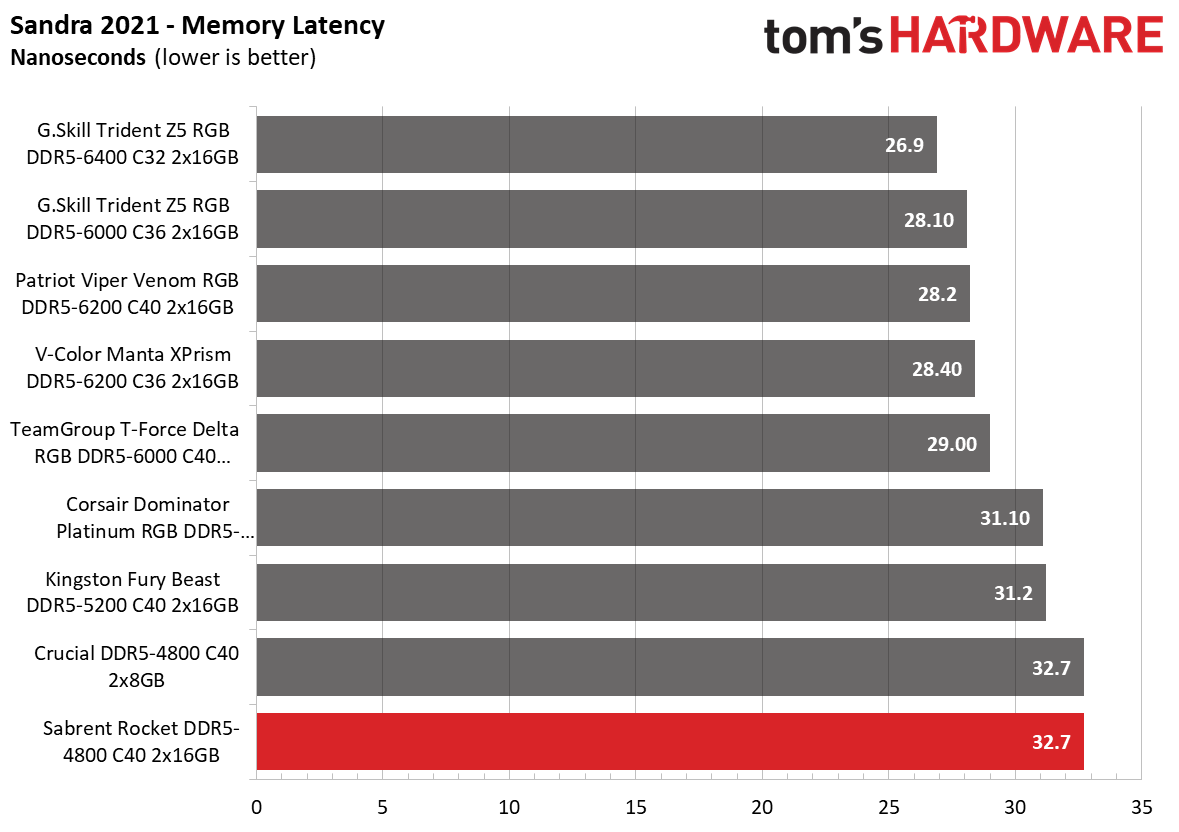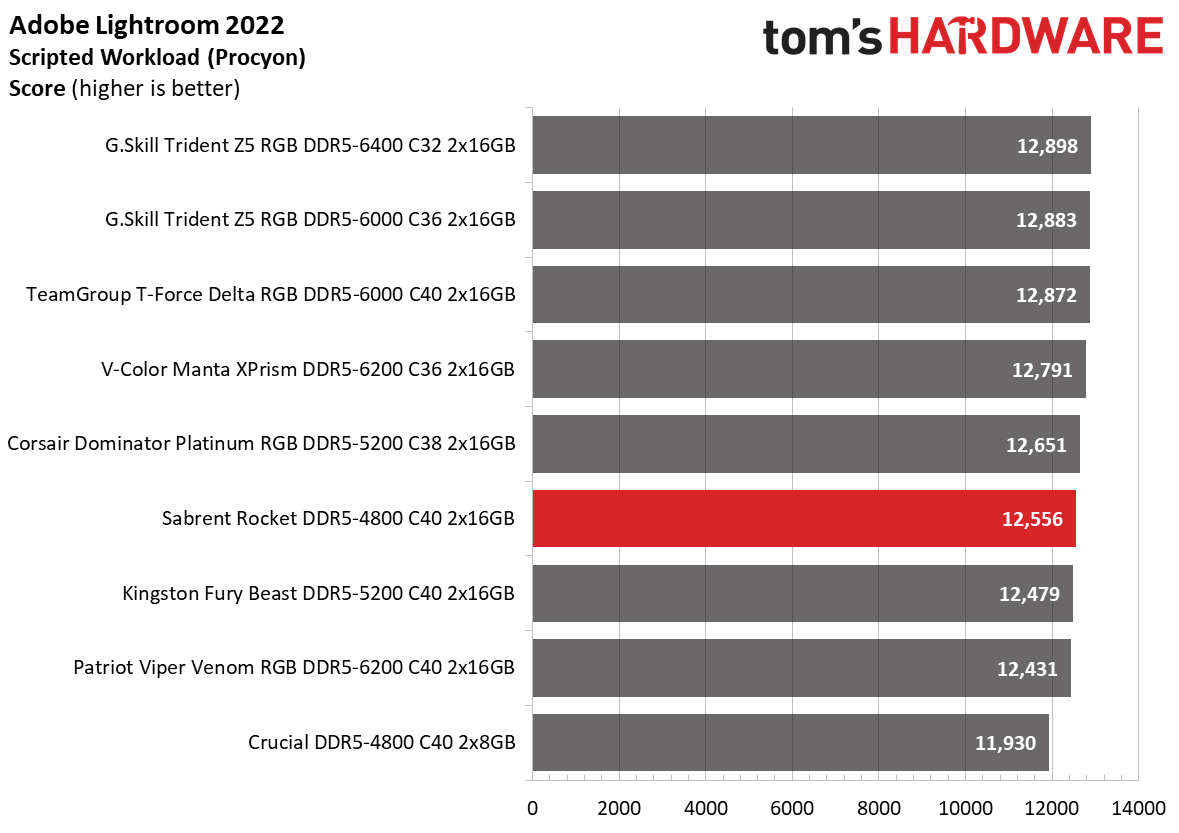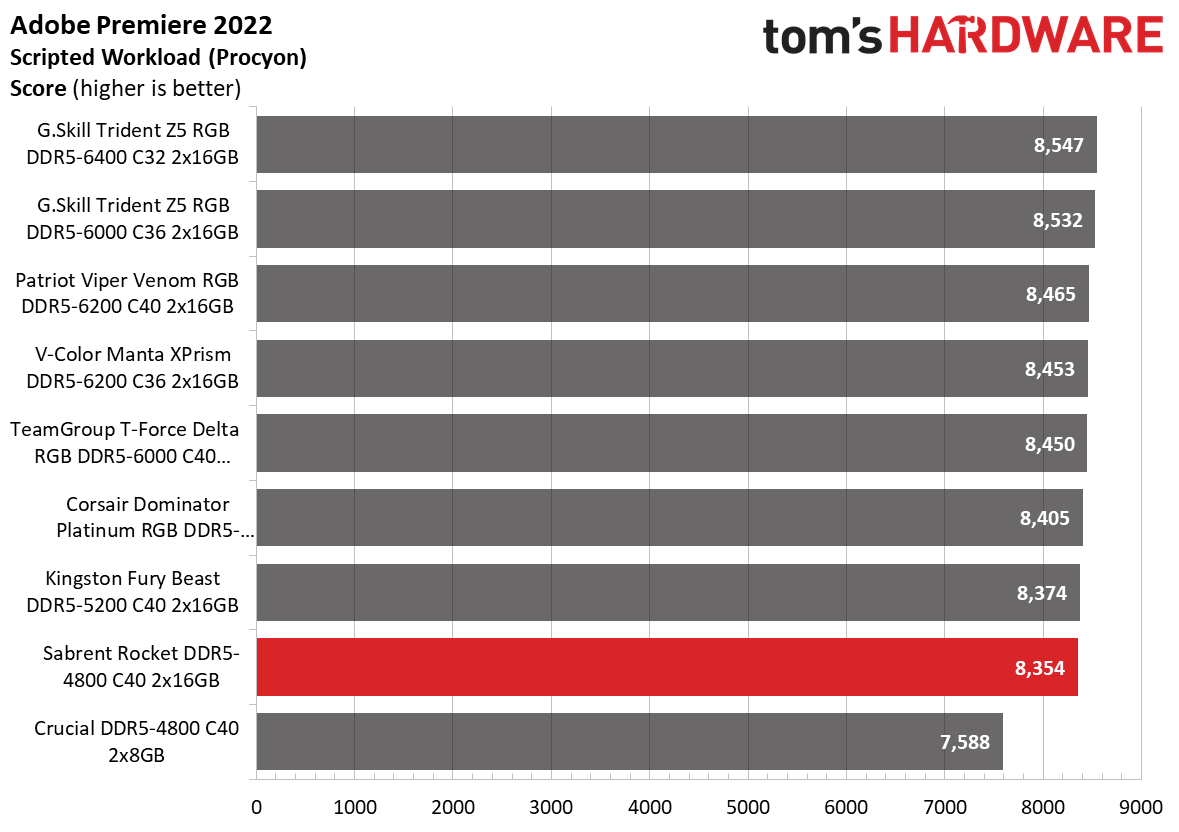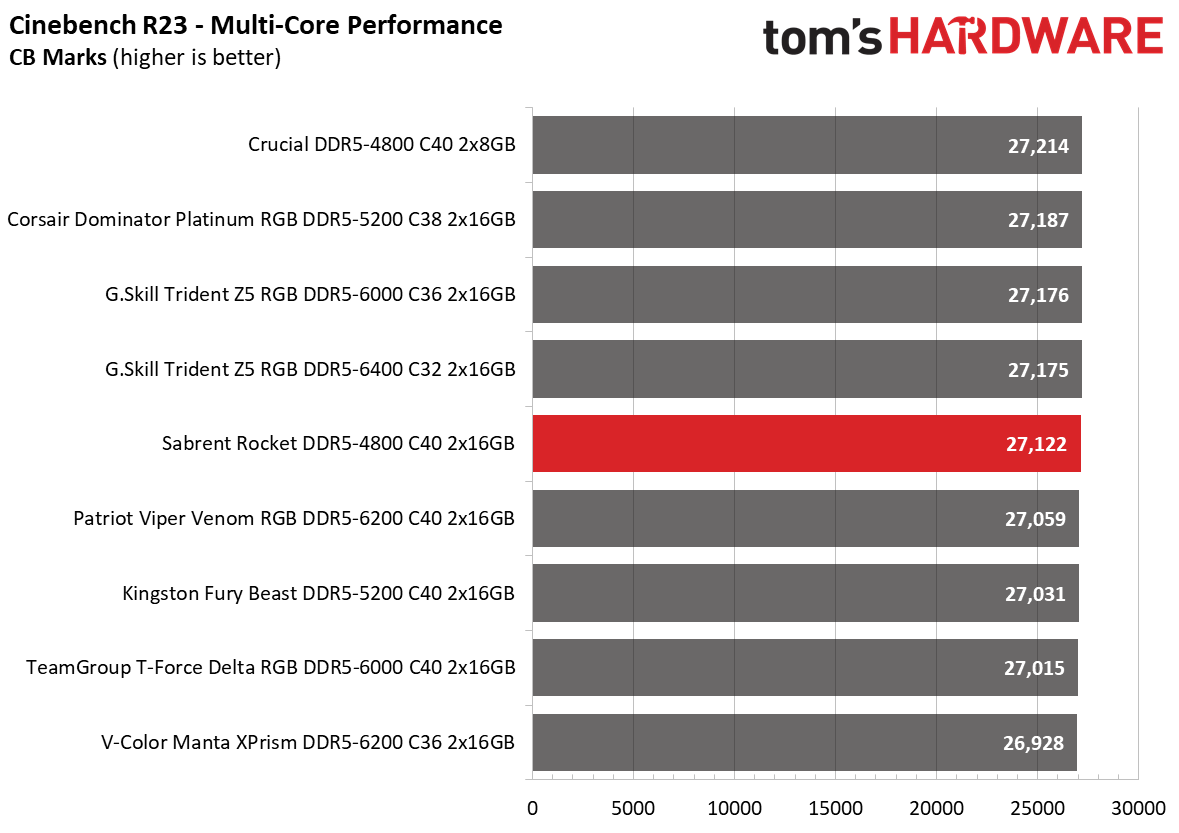Tom's Hardware Verdict
The Sabrent Rocket DDR5-4800 C40 is just like an ordinary DDR5-4800 memory kit. It isn't until you start overclocking it that you will see its actual value.
Pros
- +
Overclocks great
- +
Low-profile design
Cons
- -
A bit on the expensive side
- -
Flimsy heat spreader
- -
One-year warranty without registration
- -
Only available as individual DIMMs
Why you can trust Tom's Hardware
Sabrent's new Rocket DDR5-4800 memory marks a sharp departure from the norm for the company. Sabrent has earned a spot on the list of popular storage vendors, with several products cementing their place on our list of best SSDs. The company was also the first to offer the world’s largest M.2 SSD in the shape of the Rocket 4 Plus 8TB. However, not complacent with being known for its SSDs, Sabrent recently decided to branch out to new horizons, specifically, the memory market.
The brand isn’t ready to go gung-ho on memory, and it’s understandable since the memory market is uncharted territory for Sabrent. Therefore, the company has taken a more cautious approach, only offering baseline DDR4 SO-DIMM and DDR5 memory for the moment. It’s Sabrent’s way of conducting a pilot test to determine whether it’s worth it to stay the course of the new venture or not.



If you own or have seen Sabren'ts Rocket or Rocket 4 Plus SSDs, you'll recognize the design immediately. The memory utilizes a black PCB with a two-tone copper heat spreader for heat dissipation. Sabrent took the design from its SSDs and inverted the colors. Aesthetically, the heat spreader looks fine, but its construction is questionable. It's a thin copper sheet you could take off with your fingers, but you wouldn't want to remove it since it's so fragile that it's susceptible to bends and kinks.
The run-of-the-mill DDR5 memory modules are 31.15mm (1.23 inches) tall. Sabrent's Rocket memory modules measure 31.5mm (1.24 inches), so the heat spreader doesn't add much height to the memory. That's good news since you won't worry about clearance space for oversized CPU air coolers. Sabrent only offers its memory in single-DIMM packages, so you won't find any multi-stick kits.


The Sabrent DDR5-4800 memory modules use SK hynix's H5CG48MEBDX014 (M-die) integrated circuits (ICs). There are eight of them, each 2GB to make up the total capacity of 16GB per memory module. The power management IC (PMIC) on the Sabrent memory modules is the famous P8911 (P8911-Y0Z001GR-2143TB) that hails from the Renesas camp.
These are baseline memory modules, so there's nothing to configure. There aren't any XMP 3.0 profiles onboard whatsoever. Instead, it's plug-and-play at its maximum expression. Sabrent's memory sticks to DDR5-4800 with 40-40-40-76 timings and a 1.1V DRAM voltage. See our PC Memory 101 feature and How to Shop for RAM story for more on timings and frequency considerations.
Comparison Hardware
| Memory Kit | Part Number | Capacity | Data Rate | Primary Timings | Voltage | Warranty |
|---|---|---|---|---|---|---|
| G.Skill Trident Z5 RGB | F5-6400J3239G16GX2-TZ5RK | 2 x 16GB | DDR5-6400 (XMP) | 32-39-39-102 (2T) | 1.40 | Lifetime |
| V-Color Manta XPrism | TMXPL1662836WW-DW | 2 x 16GB | DDR5-6200 (XMP) | 36-39-39-76 (2T) | 1.30 | Lifetime |
| Patriot Viper Venom RGB | PVVR532G620C40K | 2 x 16GB | DDR5-6200 (XMP) | 40-40-40-76 (2T) | 1.35 | Lifetime |
| G.Skill Trident Z5 RGB | F5-6000U3636E16GX2-TZ5RS | 2 x 16GB | DDR5-6000 (XMP) | 36-36-36-76 (2T) | 1.30 | Lifetime |
| TeamGroup T-Force Delta RGB | FF3D516G6000HC40ABK | 2 x 16GB | DDR5-6000 (XMP) | 40-40-40-80 (2T) | 1.35 | Lifetime |
| Corsair Dominator Platinum RGB DDR5 | CMT32GX5M2B5200C38 | 2 x 16GB | DDR5-5200 (XMP) | 38-38-38-84 (2T) | 1.25 | Lifetime |
| Kingston Fury Beast | KF552C40BBK2-32 | 2 x 16GB | DDR5-5200 (XMP) | 40-40-40-80 (2T) | 1.25 | Lifetime |
| Crucial | CT2K8G48C40U5 | 2 x 8GB | DDR5-4800 | 40-39-39-77 (2T) | 1.10 | Lifetime |
| Sabrent Rocket | SB-DR5U-16G x 2 | 2 x 16GB | DDR5-4800 | 40-40-40-76 (2T) | 1.10 | 5 Years |
Our DDR5 test system consists of Intel's Core i9-12900K flagship Alder Lake processor with Corsair's CUE H100i Elite LCD liquid cooler taking care of the cooling. The 16-core Alder Lake chip resides on the MSI MEG Z690 Unify-X motherboard, running the 7D28vA8 firmware. On the other hand, the MSI GeForce RTX 2080 Ti Gaming Trio is responsible for our gaming RAM benchmarks.
Our Windows 11 installation, benchmarking software, and games reside on Crucial's MX500 SSDs, whereas the RM650x feeds our entire system with power. Lastly, the Streacom BC1 open bench table ensures all of our hardware is well kept and tidy.
Get Tom's Hardware's best news and in-depth reviews, straight to your inbox.
| Header Cell - Column 0 | Intel DDR5 System |
|---|---|
| Processor | Intel Core i9-12900K |
| Motherboard | MSI MEG Z690 Unify-X |
| Graphics Card | MSI GeForce RTX 2080 Ti Gaming X Trio |
| Storage | Crucial MX500 500GB, 2TB |
| Cooling | Corsair iCUE H100i Elite LCD |
| Power Supply | Corsair RM650x 650W |
| Case | Streacom BC1 |
Intel Performance




















No one expects DDR5-4800 memory to outperform overclocked memory. However, regarding performance, the Sabrent memory kit is right where it should be. It's sufficient for the average consumer but won't appease the more hardcore enthusiast who doesn't want to leave performance on the table.
Overclocking and Latency Tuning



When you run hardware outside of the manufacturer's specifications, there's always a potential risk of damage. That's the standard caveat with overclocking any hardware, not just memory. Although we've already reached out to SK hynix to inquire about the maximum safe voltage for its ICs, we haven't received any feedback on safe voltages for overclocking. However, after speaking with various memory vendors, they've agreed that 1.4V is the maximum voltage you would want to pump into DDR5 for an extended time.
The Rocket DDR5-4800 C40 hit the highest data rate (DDR5-6000) of all the reviewed DDR5-4800 memory kits. In addition, Sabrent's memory kit overclocked better than other premium competitors. We squeezed impressive timings (36-36-36-77) out of the memory modules at 1.4V.
Lowest Stable Timings
| Memory Kit | DDR5-4800 (1.4V) | DDR5-5400 (1.4V) | DDR5-5800 (1.4V) | DDR5-6000 (1.4V) |
|---|---|---|---|---|
| Sabrent Rocket DDR5-4800 C40 | 34-36-36-77 (2T) | N/A | N/A | 36-36-36-77 (2T) |
| Samsung DDR5-4800 C40 | 34-35-35-69 (2T) | N/A | 36-36-36-76 (2T) | N/A |
| Crucial DDR5-4800 C40 | N/A | 40-40-40-77 (2T) | N/A | N/A |
At DDR5-4800, we could get the timings down to 34-36-36-77 from the default 40-40-40-76. Then, of course, we had to up the DRAM voltage to 1.4V to stabilize the memory. The timings were the same as for DDR5-6000, except for the CAS Latency (CL), which we got down to 34 clock cycles.
Bottom Line
The way we see it, Sabrent’s Rocket DDR5-4800 C40 memory kit caters to two potential groups of consumers. In the first group, we have the average user who wants cheap DDR5 memory for their new Alder Lake build. On the other hand, we have the daring enthusiast who wants an affordable memory kit to overclock for extra gains. But, of course, no company would ever offer buyers the guarantee that its memory kit will reach a specific frequency. Many vendors even frown upon consumers running their products out of specification.
One aspect of the Rocket DDR5-4800 C40 that may make consumers uneasy is the warranty. Sabrent only backs the memory kit with a limited one-year warranty without registration, but registering the product nets you a five-year extension. In a market where most memory comes with a limited lifetime warranty, Sabrent’s memory kit is at a disadvantage.
The brand currently sells its Rocket DDR5 memory as single modules only — there are no kits. The 16GB memory module costs $179.99; therefore, a dual-channel configuration will set you back $359.98. The pricing is a bit steep considering that rivals like the Fury Beast DDR5-5200 C40 are cheaper and faster right out of the box.

Zhiye Liu is a news editor, memory reviewer, and SSD tester at Tom’s Hardware. Although he loves everything that’s hardware, he has a soft spot for CPUs, GPUs, and RAM.
